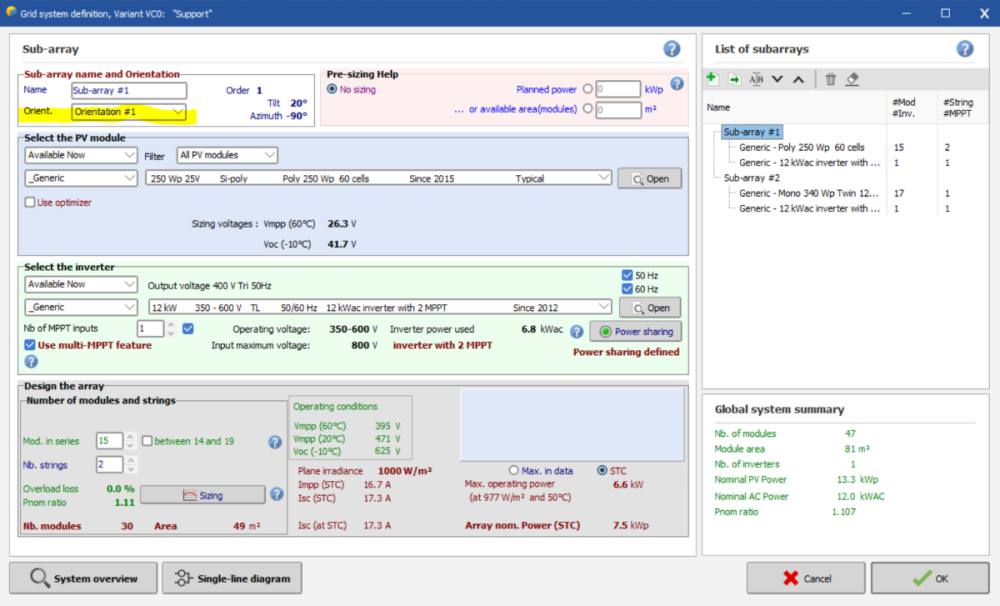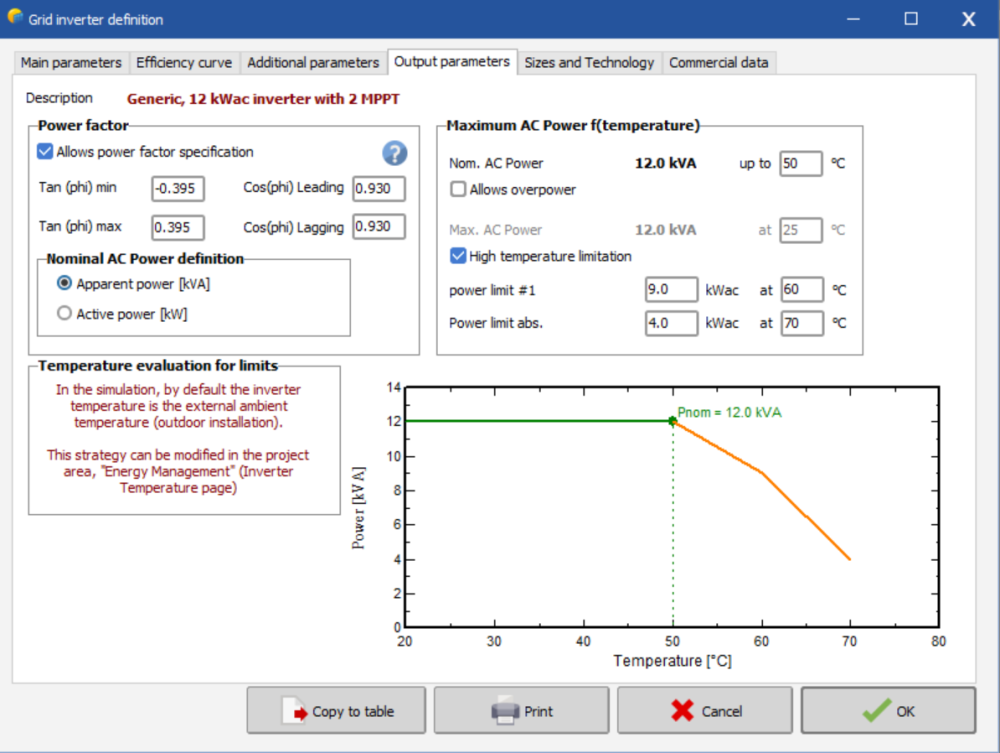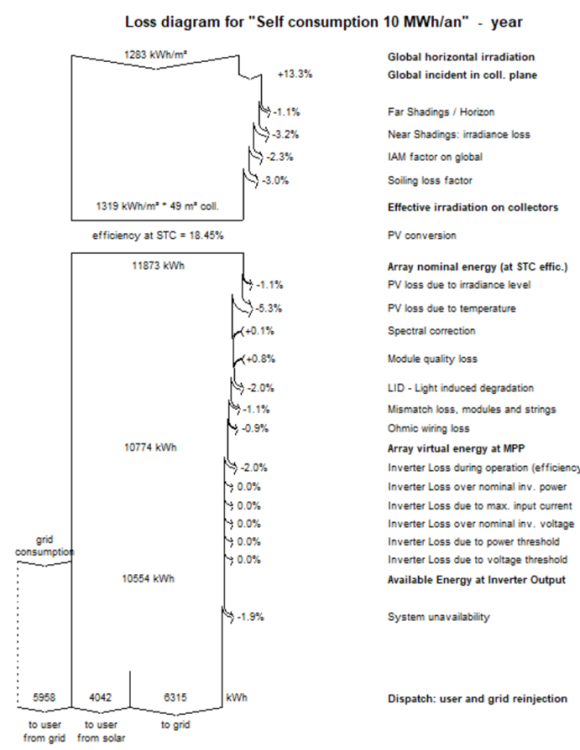-
Posts
297 -
Joined
-
Last visited
Everything posted by Linda Thoren
-
Dear Reza, By "position of the modules", do you mean the location of the installation? The simulation output is based on metrological data that will differs significantly depending on the location. Thus it is not the location per se that is necessary but hourly values of the position of the sun, the irradiance, temperature etc. If you refer to how the tables a placed compare to each other, this can be done in the Near shading and the scene can be saved and exported an image. Kind regards
-

How to Combine Two Different Thermal Constants in a Single Simulation
Linda Thoren replied to Eduardo.lopez's topic in How-to
Dear Eduardo Lopez, Thank you for your question and for outlining your specific use case. Currently, it is not possible to define different thermal constants within a single simulation, this might be something we can develop in the future. Possible work arounds would be to make a weighted average or divide the project, simulating one variant for each Uc value. Kind regards -

How to select different number of module in 2 arrays
Linda Thoren replied to Tia's topic in Problems / Bugs
Dear Tia, To configurate one string with 5 modules in series and a second with 6 modules in series, you should define 2 sub-arrays (see a list of your sub-arrays to the right in the system window). You can copy your first sub-array, modify the number of MPPT inputs, modules in series and in strings and activate the Power sharing feature, to share the power of the two sub-arrays within the same inverter. We have a youtube tutorial on this subject that further explains how to configure the sub-arrays, the use of the MPPT feature and the Power sharing: You can also fins more examples on the PVsyst help page: https://www.pvsyst.com/help/multi_mppt_use.htm https://www.pvsyst.com/help/multi-mppt_more-examples.htm Kind regards -

How to simulate PVSYST for one day in hourly values?
Linda Thoren replied to hritik's topic in Meteo data
Hello, In the Advanced Simulation window (the button right under Run Simulation) you can precise which dates you want to simulate and by creating a output file, you have the possibility to create a .csv file with hourly, daily or monthly time steps for any simulation variables that are relevant for your project. Kind regards -
Hi! Thank you for your input and concrete example. In PVsyst, peak shaving has primarily been developed as a strategy to manage scenarios with grid limitations by shifting the production peak, rather than as an economic strategy for discharging at peak prices or peak electricity consumption. Further development of storage strategies is planned for next year. Kind regards
-
Hello, The Pnom ratio, also known as the DC-AC ratio, refers to the ratio of the nominal DC power output of a solar panel array to the nominal AC power capacity of the inverter, indicating how much DC capacity is installed relative to the inverter's AC capacity. Thus, the Pnom ratio changes if you adjust the number of panels installed or the capacity of the inverter. Kind regards
-
Hello, In the following youtube tutorial you find the information of how to define a self-consumption profile in a grid-connected system: Kind regards
-
Yes it is possible to import a load profile through the self consumption window. For the importing of hourly or sub-hourly parameters in PVsyst, you must use the following standard format: -Text file (CSV format with commas or semicolons). -All lines beginning with the hash symbol '#' are assumed to be comments, and will be ignored. -Blank lines are ignored. -The first line that does not start with #, holds the column titles. The first two columns should be "Date", and "P Load", further columns are ignored. -The following line contains the units of the data in the columns. The date should have no units, the units for the load can be power ([W], [kW] or [MW]) or energy ([Wh], [kWh] or [MWh]). -Then there follow the lines with the values, one line per data entry. -The date and time in the first column can be given either in European format (DD/MM/YY hh:mm) or in US format (MM/DD/YY hh:mm). -The file should contain all hours of a generic year (from 01/01 at 00:00 up to 31/12 at 23:00). Only day and month will be retained, the year will be ignored. -These dates/hours do not need to be related to the dates of your input meteo file: they are for each hour of a generic year. Please also see our youtube tutorial of how to define a self consumption profile in a grid connected system: Kind regards
-
Hello, First you define your different orientations using the field type multiple orientations in the Orientation window. In the system window you can create multiple subarrays (see the List of subarrays to the right) and assign each subarray to an orientation (see the list of orientation that you have defined previously, in the Sub-array name and Orientating angle, orientation highlighted in the print screen below). If your inverter has multiple MPPTs input, you can activate the Use multi-MPPT feature and assign a number of MPPT inputs to each sub-array and use the Power sharing feature for sharing of Nominal Power between MPPT inputs of a same inverter. You can find more detailed explanations of the MPPT feature and Power sharing in the following help pages: https://www.pvsyst.com/help/multi_mppt_use.htm https://www.pvsyst.com/help/powersharing.htm https://www.pvsyst.com/help/multi-mppt_more-examples.htm Kind regards
-
You can see and modify the parameters for your components either from the databases tab in the first PVsyst window, or by clicking "Open" next to the chosen component in the System window in your variant. In the "Output parameters" in the grid inverter definition (in PVsyst this file is called an OND file), you find the parameters linked to the Power factor, see print screen below. By ticking the option Allow power factor specification, the limitation in the Energy management tab will disappear. In the following youtube tutorial you have further information about how the inverter is defined in the PVsyst database: Kind regards
-

More than 8 orientation, and cause error after imported 3d scene into pvsyst
Linda Thoren replied to garf's topic in How-to
Hello, The method suggested above is to increase the tolerance set as default to 1° to a higher value, allowing to group various (but similar) tilts together. Then you should define the system configuration with different sub-arrays for each orientation in the System window. It is indeed possible to have different orientation of the same inverter, though a string cannot be split over two orientations in PVsyst. Don't hesitate to contact us again if you have further questions, either posting in the forum or sending an email to support@pvsyst.com Kind regards -
If the strings have the same lengths, it is sufficient to just untick the Use multi-MPPT feature and define the total number of strings to the inverter. If the strings have different lengths indeed you you will have this constraint in the current version that you can not have empty MPPT inputs. To get around the constraints in PVsyst, you could modify the OND file to 4 MPPTs instead of 6, though by default, PVsyst assumes that an inverter with e.g. 2 MPPT inputs behaves as 2 identical inverters of half the power. You thus might have to adjust other parameters too to correspond to the use-case you are referring too. In the following help page you find more information of how PVsyst defines multi_MPPT inverters: https://www.pvsyst.com/help/multi_mppt_use.htm
-
Hello, Defining a bifacial system with a 3D scene comes with certain constraints, ensuring the regularity of the arrangements of tables for the bifacial 2D model computation. You can read more about the 2D model conditions in the following help page: https://www.pvsyst.com/help/bifacial-conditions.htm The threshold for regular pitch can be modified in the advanced parameters, by changing the value "Pitch RMS limit for bifacial 2D models" Kind regards
-
Hello, In PVsyst it is possible to define an hourly self-consumption profile and in the economic evaluation you can also define precise tariffs for electricity sale as well as calculating the gain from self-consuming compared to grid consumption. I link 2 video tutorials below. A large enough system will fulfill the energy need by day, as well as injecting the excess energy into the grid. For example, below you see the loss diagram for the DEMO Residential system at Geneva variant VC4 : The result is divided in to user from grid, to user from solar and to grid. You can also include a battery storage solution to increase the self-consumption, though it is not yet possible to inject energy stored in the batteries to the grid (unless you use the peak shaving strategy, that can not be combined with a self-consumption profile) In the Advanced Simulation window, you can then create an Output file with all the relevant parameters for your project in Daily or Hourly timesteps. I hope this helps to get started with your Net billing project, Kind regards
-

Diff. Orientations in the same string and same MPPT input
Linda Thoren replied to Umut's topic in How-to
Hello, It is not possible to have multiple orientations on the same string. If you have two or more strings, it is possible to put two orientations on the same MPPT input by using the Mix orientation 1 and 2 option (you might have to change the order of the orientation since it in this version of PVsyst is only possible to mix orientation 1 and 2). Kind regards -
You have chosen a 7.0 kW inverter, and panels with a nominal power of 5.0kW, thus the inverter is a bit oversized. With an orange warning you can still run the simulation. Please look at the following video tutorial for more information about the sizing: Kind regards
-
Thank you for your suggestion. This might be developed in a future version, though it is not yet on our roadmap and will not be available any time soon. In our experience, this strategy corresponds well to what users expect from a battery storage solution for increased self-consumption, to charge when excess solar power is available during the day, and discharge as soon as the user needs power - which normally is during the night. Kind regards
-
Dear Rosana, Indeed, by using the Self consumption strategy, the batteries will charge when excess solar power is available and discharge as soon as the user needs power. It is not possible to define specific hours for charging/discharging. Kind regards
-
Dear Loïs Masson, Indeed the panels included in the database has gone through a certain level of control. But implemented in the software is also warning messages and information concerning in particular the IAM curve and low light efficiency. If you open a PAN file, you typically will have this kind of message encouraging you to have a look at the IAM curve. In the Additional Data, Custimized IAM you can modify an over evaluated IAM curve by choosing the Default Fresnel. This manipulation can also be done through the detailed losses window, IAM Losses tab. Below I attach a link to how the IAM profile is determined and what kind of data you possibly could ask the supplier to provide Kind regards
-
Hello, E_User is the Energy supplied to the user and correspond to the load-profile that you have defined. E_Solar correspond to your self consumption, i.e. the energy to the user from your solar installation. EFrGrid is the energy from the grid needed to fulfill the user's load-profile, the E_User. So in this case E_User = E_Solar + EfrGrid, and it seems to be accurate in your results.
-
Dear Oussama Belarbi, Thank you for bringing this to our attention. It appears that this issue is a bug introduced in the current version. The issue is reported and we will work to resolve it in a future version. In the meantime, you can either revert to a previous version or create an hourly load profile as a CSV file and instead use the Load values from a CSV hourly/daily file option Kind regards
-
For the dimensioning in the system window, PVsyst show graphs based on the values defined in the project settings e.g. -10°C by default for the Lower temperature for Absolute Voltage limit, not from the local site temperature data. This value is supposed to represent the lower value ever measured at the site and this value will not impact the simulation and works only as a guide for the dimensioning of the system. The simulation will be done with the temperatures from the weather file of your site.
-

PVsyst red error message not aligning with calculations.
Linda Thoren replied to Vera's topic in Simulations
The dimensioning messages are based on the data and limitations in the panel and inverter file and the main electrical characteristics are calculated under chosen operation conditions using the one-diode-model. Verify that the temperature coefficient under the Model parameters in the panel file is correct, see the following help page regarding the temperature coefficients: https://www.pvsyst.com/help/pvmodule_tempcoefficients.htm https://www.pvsyst.com/help/pvmodule_corrtemper.htm The limit of Voc at -10 degrees is set in the project settings, where the threshold of -10 degrees can be changed to reflect the coldest temperature observed at the site. You can read more about the Array voltage sizing in the following help page: https://www.pvsyst.com/help/systemgrid_vocond.htm Kind regards -
Hello, In the current version of PVsyst it is not possible to use bifacial panels in the off-grid system. To use bifacial panels, you should define a grid-connected system, define a self consumption profile and not allow injection to the grid when defining the battery storage. Energy injected from the grid to fulfill the energy need should be considered as missing energy if the system indeed is not connected to the grid. It is not possible to mix bifacial and monofacial arrays in the same system, though you can create multiple variants and simulate the two different systems individually. Kind regards





